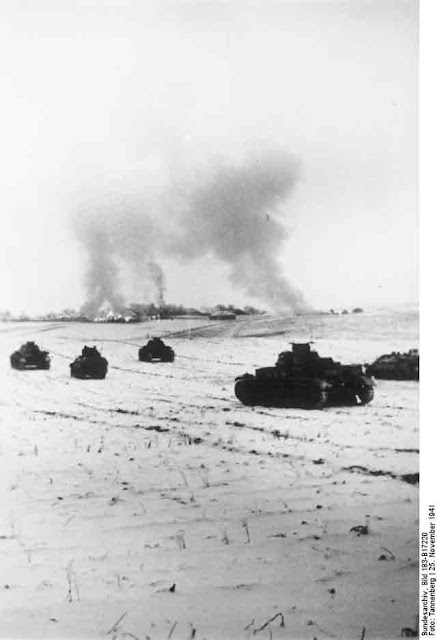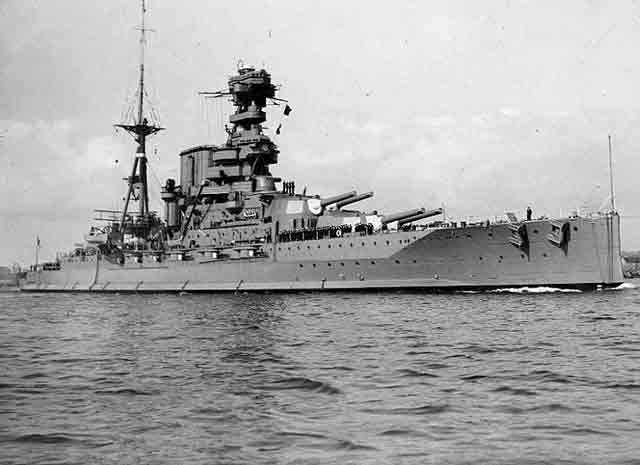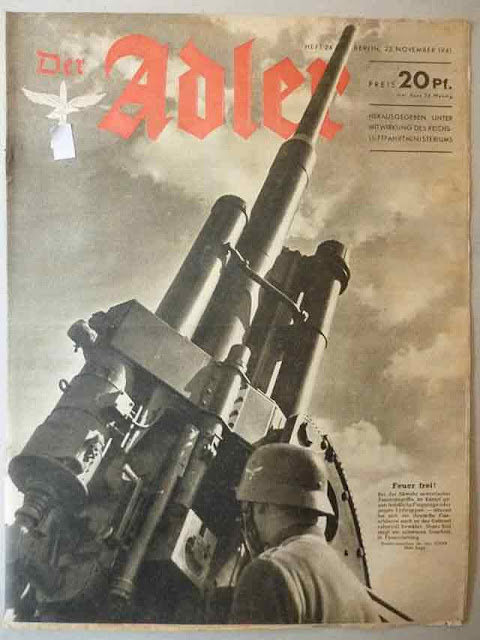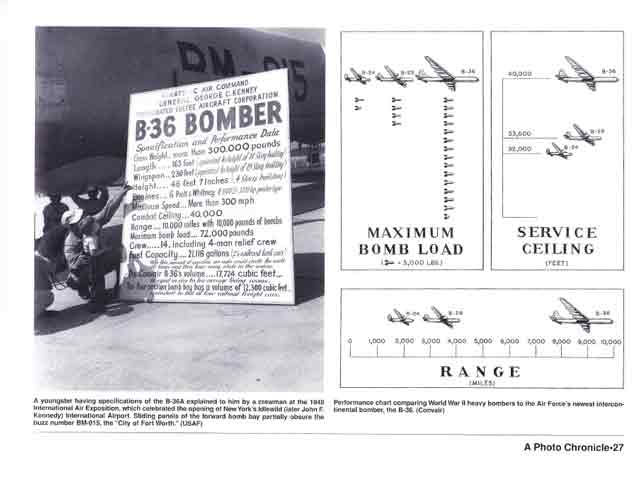Friday 11 April 1941
 |
| Tea and sandwiches from a mobile canteen, courtesy of the Ministry of Food. Coventry, England, 11 April 1941 (Photo by Central Press/Getty Images via Los Angeles Daily News). |
Operation Marita/Operation 25: On
11 April 1941, Hungary sends its forces, the 3rd Army, across the Yugoslav border in the morning. Admiral Horthy did not invade during the initial German crossings because he claimed to feel bound by the fact that Yugoslavia also had signed the Tripartite Pact. However, once Croatian separations proclaimed a new state in Zagreb, he decided that Yugoslavian no longer existed, and thus the Pact no longer applied.
Italy also is advancing south. General Ambrosio's 2nd Italian Army makes progress from Trieste, both south along the coast and toward Ljubljana. One of Ambrosio's intentions is to link up with the Italian forces in Albania, but for some reason, the Yugoslav Army has committed some of its best formations in that theater, and the going is slow.
Sepp Dietrich's 1st SS Panzer Division Leibstandarte SS Adolf Hitler (LSSAH) brigade is at the spearpoint of the German drive south from Vevi through the Klidi/Kleisoura Pass area (also known as the Kirli Derven). The defense is centered around the town of Kelli and the pass itself, and the German objective is the town of Kliki at the southern entrance to the pass.
"Panzer" Meyer's reconnaissance battalion ran into a mixed Greek /British /Australian /New Zealand force ("Mackay Force," named after Australian General Iven Mackay) on this drive south on the 10th, stopping it cold. The Germans regroup, and in the afternoon try to force their way down the main road. The hugely confident Germans drive their troops forward in lorries within sight of the defenders, which irks some on the Allied side. The Allied forces under Captain Gordon Laybourne Smith of the 2/3rd Field Regiment respond with accurate artillery fire, destroying five German trucks, which quickly forces the Germans to pull back.
The Germans again regroup and launch an attack in the evening. It then begins to snow. The Australians and New Zealanders have difficulties with their weapons and are exhausted from their quick march from their bivouacs on the Aliakmon Line, but they hold the line for the time being.
The German 30 Corps and Corps and XVIII Mountain Corps, and opposing British and Greek troops, continue to eye each other across the Aliakmon River just west of Thessaloniki. However, the Germans do not attempt to cross the river. Their basic strategy is to wait until the LSSAH and the rest of XL Corps advances to the west of the British line, then smash it between the two German formations. The British, meanwhile, are looking anxiously over their shoulders toward the advance of the LSSAH and related formations. They are shifting troops northwest to try and prevent this breakout.
The air war over Greece is going very well for the Germans at this point. The Luftwaffe bombs and sinks 674-ton British cable ship Retriever off Phleva Island, Greece. There are 11 deaths, and 6 men become prisoners. There are 29 men who are rescued by the Allies.
British Middle East Commander General Archibald Wavell meets with General Henry Maitland Wilson in Athens to discuss the situation. Among other things, they discuss a possible evacuation
The Greeks also are recognizing the likelihood of defeat. King George II requests permission to establish his government in Cyprus - but is told to stay in Athens.
 |
| "British troops use a bulldozer to pull down a fascist stone monument at Kismayu in Italian Somaliland, 11 April 1941." © IWM (E 2367). |
European Air Operations: The Luftwaffe bombs Bristol with 153 aircraft in "The Good Friday Raid." It is the sixth major raid of the city, the first having been on 24 November 1940 - and the last. More than 1400 people have been killed in the raids, and the town's medieval center has been destroyed.
The primary damage is to the dock area (including Prince Street, Canon’s Marsh and Queen Square ) and residential areas. The raid causes a lot of damage, but it more notable in a historical context from some odd facts. First, that the Germans lose seven Heinkel He 111 bombers to Hurricanes from RAF No. 151 Squadron. Second, St. Philip's Bridge is hit, which disrupts power to the tramways - which are scrapped as a result. Thus, this raid ends tram service in Bristol forever.
Another Luftwaffe raid by 18 Heinkels made is on Bridlington. There are two deaths amidst a lot of damage, including to Lloyd Hospital. One of the deaths is a two-year-old boy.
The RAF conducts Rhubarb operations over Occupied France with 20 planes.
Visiting Australian Prime Minister Robert Menzies summarizes the air-war outlook presented at the day's War Cabinet meeting:
More bombing of aircraft factories in England. The Hun is becoming too accurate, and picking our factories off too regularly.
First Sea Lord John Tovey comments that the Luftwaffe has command over the skies in the Straits of Sicily, affording protection to the Italian convoys that supply the Afrika Korps.
East African Campaign: The Italians for all intents and purposes have been evicted from their ports in East Africa or have scuttled their ships in the few that remain. Accordingly, President Roosevelt quickly lifts his designation of the Red Sea/Gulf of Aden as a "combat zone." This means that US freighters are free to bring supplies directly to the British troops there.
Battle of the Atlantic: President Roosevelt informs Prime Minister Winston Churchill that he intends to shift the US Security Zone to 26 degrees west. He further intends to have US escorts for convoys to that point and requests that the Admiralty provide the US Navy with convoy information to accomplish this purpose. This is an astonishing request - anyone with that information holds the fate of Great Britain in his hands - but such is the trust between the two men that there is no question but that Churchill will supply the information. It just shows the depth of the relationship between England and the United States in this situation.
U-124 (Kptlt. Georg-Whilhelm Schulz), operating in the vicinity of the Cape Verde Islands, torpedoes and sinks 5285-ton Greek freighter Aegeon. There are four deaths.
Royal Navy 201-ton boom defense vessel HMS Othello and 56-ton boom tender HMS Yorkshire Belle, apparently operating very closely together, hit a mine and sink together at the entrance to the Humber. There are 11 deaths on the Othello and four on Yorkshire Belle.
Royal Navy destroyer HMS Blankney (L-30, Lt. Commander Philip F. Powlett) is commissioned.
 |
| Associate Justice to the US Supreme Court Hugo. L. Black pens a note to legal scholar and author Beryl H. Levy, 11 April 1941. |
Battle of the Mediterranean: The Afrika Korps has surrounded Tobruk on the landward side with the 5th Light Division and the Brescia Division, but of course the British supply route from Alexandria remains intact through the port. A sandstorm hits the perimeter during the afternoon, and the Germans use that as cover for an attack. However, the Australian/British troops focus their artillery on the trucks that have brought the Germans close to the perimeter, destroying many. The German attacks make no progress.
To the south, the British send a group of 14 tanks to relieve the port. Panzerjäger-Abteilung (Sfl.) 605 is waiting for them, however, and knocks out half a dozen of the tanks. This sends the British at El Adem into further retreat, so Lieutenant General Rommel sends his own panzers in pursuit of Bardia. They set off at once, not waiting for daybreak, reflecting the excellent morale in the Afrika Korps. Rommel also orders Forward Detachment Knabe (Gustav Georg Knabe) to join the pursuit toward Sollum in the morning.
Royal Navy gunboats HMS Aphis and Gnat continue their bombardment of the Libyan coast that they began last night. Tonight, they bombard Bomba and the Gazala airfield. A squadron led by light cruiser HMS Orion begins a two-day sweep along the Cyrenaican coast in Operation MBD 3.
British 6372 ton freighter Thurland Castle delivers a load of (apparently Italian) captured tanks from Tobruk to Alexandria. The two escorting destroyers, HMS Vendetta and Waterhen, then immediately turn around and escort another freighter back to Tobruk on a similar mission.
The Luftwaffe bombs and badly damages 2018 ton British freighter Draco in Tobruk Harbor. The captain quickly beaches the ship, where it makes a tempting immobile target for further raids. There is one death, a gunner.
The Royal Navy is determined to interdict the Italian convoys running from Naples to Tripoli, so they send out four destroyers from Suda Bay, Crete to Malta. Their mission is to operate between Lampione Island and Kerkenah Bank and sink the convoy. However, they find nothing and return to port at Malta. It is unclear as of this date if the flotilla will remain in Malta to conduct further attacks. The RAF also is trying to interdict the convoys from Malta with Wellington bombers and Beauforts.
The Luftwaffe continues to have success flying out of Italian airfields. 7,/JG 26 is based at Gela, Sicily, and has many opportunities due to the heightened British concern about the convoys to Tripoli that are supplying General Rommel's Afrika Korps. Oblt. Müncheberg and Oblt. Mietusch of JG 26 shoot down Hurricanes of RAF No. 261 Squadron today among three total scored by the Staffel. I,/JG 27 is scheduled to proceed to North Africa to support the Afrika Korps, and they will be among the first to receive the newest version of the premiere Luftwaffe fighter, Bf 109Fs.
 |
| Wirth's circus, Sydney, Australia, April 11, 1941 (National Film & Sound Archive). |
Battle of the Indian Ocean: There is a lot of convoy activity in the Indian Ocean. This reflects the importance of Australian and New Zealand troops to the Allied war effort in both Greece and North Africa, and also the fact that the Empire's war machine is shifting into high gear.
Troop Convoy US 10 is forming up in Australia and New Zealand. Today, 81,235-ton converted liner Queen Mary joins the convoy at Sydney. The Queen Mary isn't even the largest ship in the convoy, that honor goes to 83,673-ton Queen Elizabeth. There are several other large converted liners in Convoy US 10: 43,450-ton Ile De France, 35,739-ton Mauretania, and 36,287-ton Nieuw Amsterdam. These ships will disperse toward their own destinations with the Nieuw Amsterdam, for instance, going to Singapore and the others going to Colombo and thence Suez. Another convoy departs Madras today heading for Singapore, and a third, Convoy BM6, departs from Madras bound for Malaya.
 |
| Manufacturing Bofors antiaircraft guns, Hamilton, Ontario, 11 April 1941 (Gordon W. Powley, Reference Code: C 109-2-0-18 Archives of Ontario, I0008800). |
German/Italian Relations: Hitler and Mussolini wind up a meeting in Salzburg. Mussolini is getting cold feet about the war (as well he might, considering his military's performance to date), but Hitler remonstrates with him to keep fighting.
Italian/Croatian Relations: Now that he is the leader of an independent state and not just a loudmouth in exile, Ante Pavelić has the standing to meet with Mussolini. Previously Mussolini went many months without deigning to meet with Pavelic, who was camped out in Florence. Now, the two men meet as leaders and discuss Italian recognition of Croatia.
Soviet/Chinese Relations: Soviet Ambassador to the Chungking government Panyushkin meets with Chiang Kai-shek and affirms that the USSR is not supporting Japan.
Anglo/US Relations: A RAF B-17 Flying Fortress (serial number AN-531) departs Seattle, Washington bound for England via Canada. Manned by a British crew, it is one of the lesser-known elements of Lend-Lease.
Special Forces: Royal Norwegian Navy destroyer HNoMS Mansfield (G 76 - on loan from the Royal Navy) parks offshore Øksfjord in the far north of Norway (north Alta Fjord). It destroys the Øksfjord fish oil factory, the British believing that fish oil is an important part of the German diet (and it also can be used to manufacture weapons). The Mansfield lands a crew of commandos who complete the factory's destruction. The mission is a success.
POWs: French officer Alain Le Ray, a company commander with the French Chasseurs Alpins (mountain troops), escapes from Colditz Castle. He is the first escapee from the prison, that is, the first to get out of prison (eventually he is recaptured). Le Ray already has escaped from a different camp and was brought to Colditz because the Germans feel it is exceptionally secure. He escapes, not through a tunnel dug from the clock tower that he has been helping to build, but on his own. Le Ray notices a deserted house near an exercise yard that the prisoners are allowed to use, and today he slips into it, waits for everyone to return to the castle, and then climbs a wall and is gone.
 |
| Manufacturing a Bofors antiaircraft gun in Hamilton, Ontario, 11 April 1941 (Gordon W. Powley, Reference code C-109-2-0-18, Archives of Ontario, 10008802). |
War Crimes: The Luftwaffe bombs and sinks 2561 ton Greek hospital ship Attiki in Doro Channel (between Euboea and Andros). There are 28 crew deaths. Hospital ships are clearly marked and intended to be left alone. It always is a fuzzy area whether such incidents can be prosecuted based on intent, accidents, mistaken identity and the like. However, make no mistake, sinking hospital ships is frowned upon by both sides.
US Military: The US Army Air Corps publishes a request asking for bids for a bomber meet the following specification:
- 450 mph/720 km/h top speed
- 275 mph/443 km/h cruising speed
- a service ceiling of 45,000 ft/14,000 m
- range of 12,000 miles (19,000 km) at 25,000 ft/7600m
These are extraordinary specifications that exceed anything in the air. In fact, there are no operational fighters in the world that can achieve that top speed, let alone bombers. US aircraft designers are left scratching their heads at this wish list. This tender, however, is the genesis, after a mid-course correction on the requirements, of post-war bombers such as the Northrop B-35 and the Convair B-36.
General George S. Patton, Jr. formally takes over command of the 2nd Armored Division. This involves promotion to Major General. Patton is one of the premier tank experts in the world, having directed tank operations during World War I. Like Rommel, Patton likes to fly above his units to see exactly what they are capable of doing.
 |
| A single panel from a U.S. comic strip, 11 April 1941. |
US Government: President Roosevelt creates the Office of Price Administration via Executive Order. Leon Henderson is charged with controlling prices and profits for the good of the war effort. This office will be in charge of rationing if and when it should occur.
British Government: Foreign Secretary Anthony Eden and CIGS John Dill have returned from their diplomatic efforts in the Balkans. They give a presentation to the War Cabinet about the situation in the Mediterranean, which visiting Australian Prime Minister Robert Menzies summarizes in his diary:
Libya represents a gross underestimate of German capacity. Tobruk is a poor place to defend, with an extended perimeter, but Dill thinks the supply of anti-tank guns and field artillery quite good.
On the larger question of overall armored strength between the two sides, Dill is reassuring. He states that Germany only has 15 armored divisions out of its 200 total divisions, while Britain is forming "as many armored divisions as humanly possible" - though he does not place a number on them.
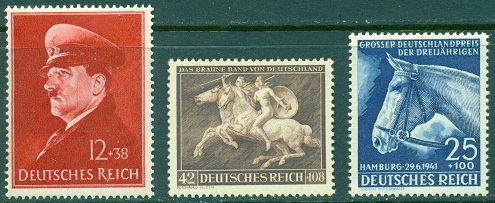 |
| The stamp portraying Hitler's likeness at left is first issued 11 April 1941. It is an early commemoration of his 52nd birthday (20 April 1941). |
German Government: Adolf Hitler is on the way in his train to his forward headquarters at Mönichkirchen. Armored train Atlas arrives in the town's station just to show how serious the occasion is.
Holocaust: The German Ministry of Propaganda publishes a one-page document called “Joodsche Weekblad” (Jewish Weekly) in Amsterdam. Ostensibly produced by the "Jewish Council of Amsterdam," it portrays Jewish life in Occupied Europe as proceeding in a fairly normal way - as opposed to the reality of the Ghettos and concentration camps.
American Homefront: The strike at the Ford Motor Company Rouge Plant ends after ten days. While both sides make concessions, the strike is a turning point in labor relations in the automobile industry because Ford becomes the last of the Big Three automakers to recognize the United Auto Workers (UAW).
Paramount Pictures releases "The Road to Zanzibar," the second "Road" comedy featuring Bob Hope, Bing Crosby, and Dorothy Lamour. The picture is written by the same writers as 1940's "The Road to Singapore," is extremely similar in terms of structure and plot - and also is similar in the huge success the film enjoys, becoming the eighth highest-grossing picture of 1941. "The Road to Zanzibar" ensures that the "Road" pictures will become a continuing series.
Starlet Deanna Durbin files papers to wed Vaughn Paul. Durbin is considered a competitor of Judy Garland, and her films reportedly saved Universal Pictures from bankruptcy. Paul is an assistant director
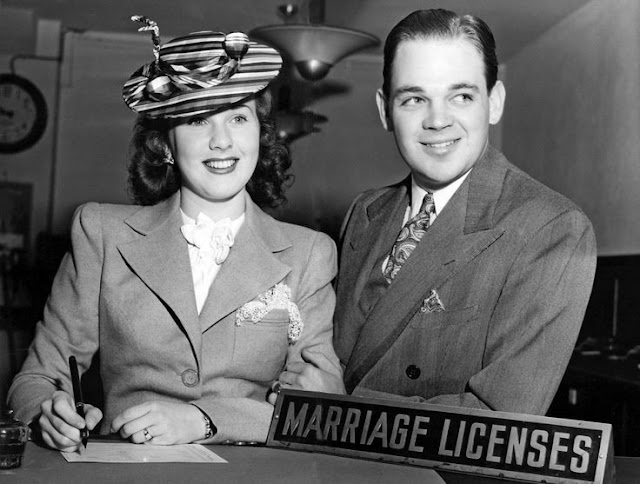 |
| Deanna Durbin marries Vaughn Paul. |
Tonight's episode of "Mandrake the Magician" is "Tommy Has Found Princess." The series features 15-minute programs featured on the Mutual Broadcasting System and airs five days a week. Raymond Edward Johnson voices Mandrake, who is based on the syndicated newspaper comic strip, created by Lee Falk.
April 1941
April 1, 1941: Rommel Takes Brega April 2, 1941:Rommel Takes AgedabiaApril 3, 1941: Convoy SC-26 DestructionApril 4, 1941: Rommel Takes BenghaziApril 5, 1941: Rommel RollingApril 6, 1941: Operation MaritaApril 7, 1941: Rommel Takes DernaApril 8, 1941: Yugoslavia CrumblingApril 9, 1941: Thessaloniki FallsApril 10, 1941: USS Niblack AttacksApril 11, 1941: Good Friday RaidApril 12, 1941: Belgrade and Bardia FallApril 13, 1941: Soviet-Japanese PactApril 14, 1941: King Peter LeavesApril 15, 1941: Flying TigersApril 16, 1941: Battle of PlatamonApril 17, 1941: Yugoslavia GoneApril 18, 1941: Me 262 First FlightApril 19, 1941: London SmashedApril 20, 1941: Hitler's Best BirthdayApril 21, 1941: Greek Army SurrendersApril 22, 1941: Pancevo MassacreApril 23, 1941: CAM ShipsApril 24, 1941: Battle of ThermopylaeApril 25, 1941: Operation DemonApril 26, 1941: Operation HannibalApril 27, 1941: Athens FallsApril 28, 1941: Hitler Firm about BarbarossaApril 29, 1941: Mainland Greece FallsApril 30, 1941: Rommel Attacks2020
